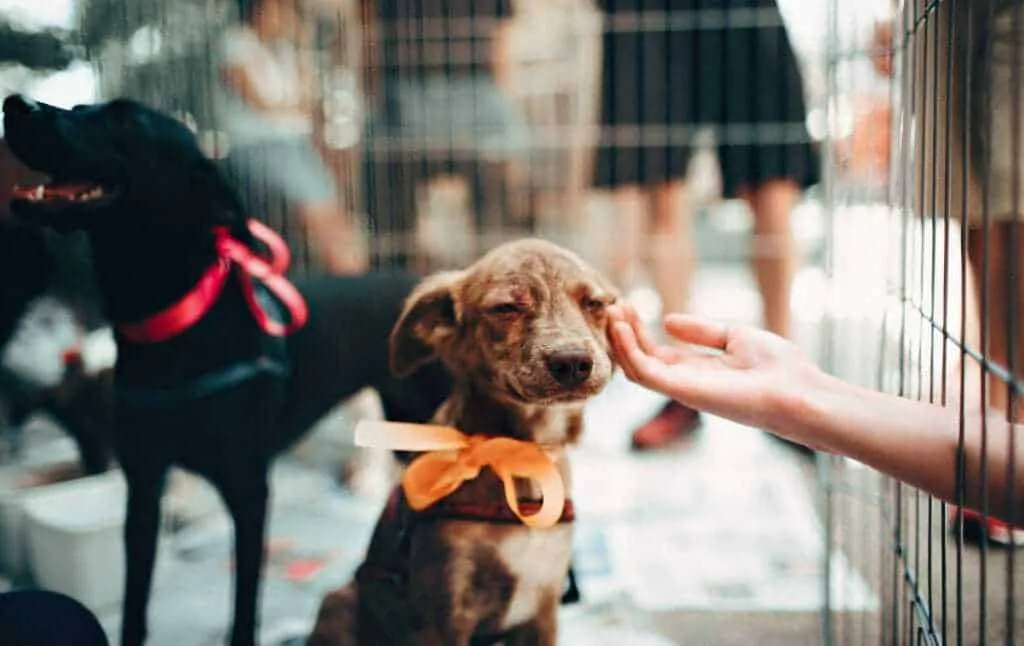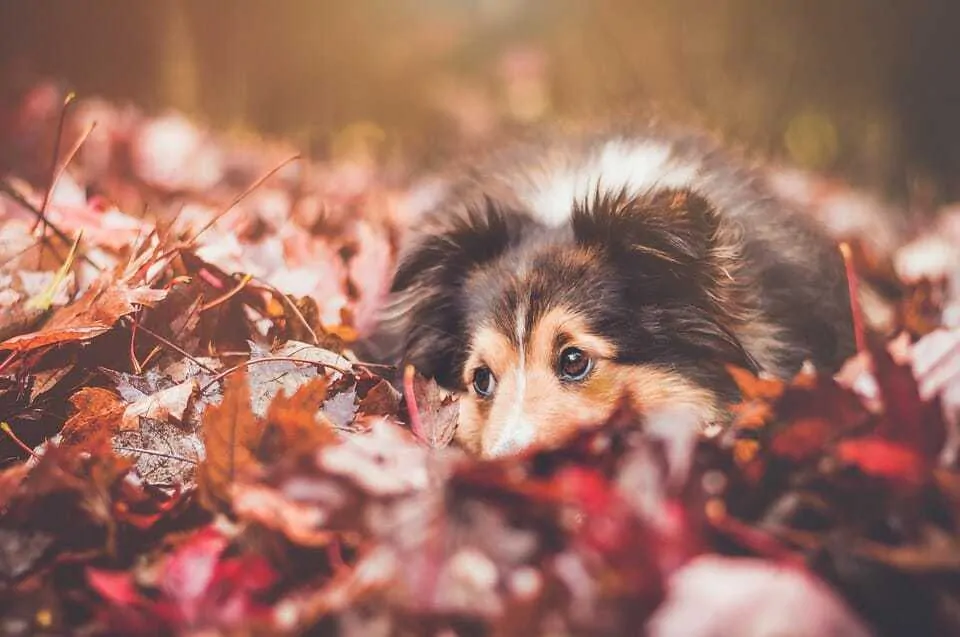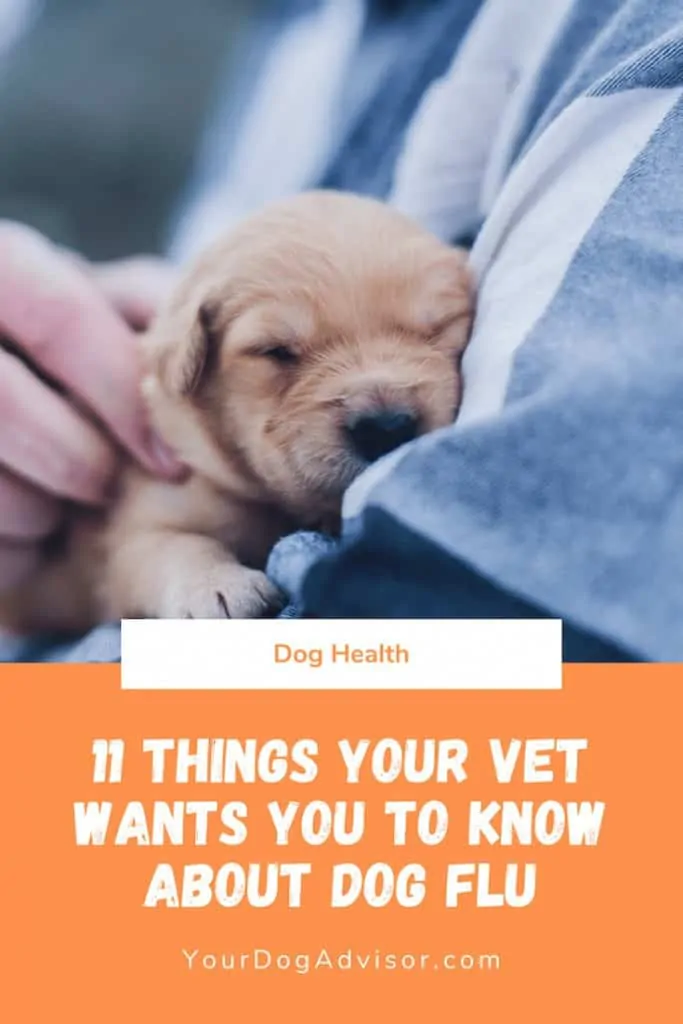Did you know that dogs can contract canine influenza, AKA the Dog Flu? That’s right. It may be surprising information to some, but to professionals in the pet care world, dog flu is becoming more and more common.
Dog flu is also no joke.
Canine influenza is a relatively new virus in the canine kingdom, and for this reason we are still learning about how it affects our four-legged friends.
And while not all cases of dog flu are fatal and in fact most cases are treatable, there are still 11 important things your vet wants you to know about dog flu.
Contents
1) What Is Dog Flu?
Canine influenza is believed to have originated from horses and reared its ugly head in 2004.
It is a respiratory infection that mirrors the human flu virus, making your dog feel weak, lethargic, and just downright awful.
Just like the human flu virus, dogs who contract the flu tend to feel downright awful.
Dog flu is has been found to be caused by Type A flu viruses, and while it is believed that the original dog flu epidemic began with horses, a second epidemic in 2011 has been found to have come from birds in Asia.
2) Dog Flu Is Highly Contagious to Dogs
Canine influenza is highly contagious, and while there are no known cases of people contracting the flu from their dogs, we now know that cats and some other mammals can contract the virus.
With that being said, many experts recommend that people wash their hands before and after handling a dog that may be infected with the dog flu, and this is for many reasons.
For starters, while you may not be in danger of catching the flu from your dog, your dog may be in danger of catching the flu from you.
Remember, dog flu is highly contagious from dog to dog and even human to dog. In fact, the canine influenza virus has been found to survive on human skin and hands for up to twelve hours.
More alarming, the virus can survive on surfaces like toys, counters, and benches for up to 48 hours.
Just like the human flu virus, the dog flu can be spread through secretions in the air from an infected dog’s sneeze or cough.
Dogs can also come into contact with the virus through you and your clothing or hands.
This means that if you are at a friends house and their dog is sick with dog flu, you could accidentally carry the virus home to your dog on our own body.
You may not be in danger of catching the flu from your dog, but your dog can catch dog flu from you.
Your dog is also at risk of catching the dog flu by drinking from a community dog bowl, playing with other dogs who are infected, or playing with toys that an infected dog had previously played with.
3) Dog Flu is Most Contagious During the Incubation Period
Unfortunately, it’s not always easy to tell which dogs are sick and which dogs aren’t. In fact, the canine influenza virus is most contagious during the incubation period, which is anywhere from two to four days.
What is the incubation period, you ask?
The incubation period is the time in which it takes for the virus to incubate in a dog’s body and make him sick.
This means that a dog may have the flu and may be highly contagious and at the same time may not be showing any symptoms.
So, when is your dog most at risk for contracting the dog flu?
Dog parks have proven to be one of the most common breeding grounds for the canine influenza virus. This is because there are a number of strange dogs at dog parks who are playing with each other, barking, play biting, licking, and nuzzling.
There are also community water bowls at dog parks and often times there are a number of universal tennis balls and other toys different groups of dogs are allowed to play with.
If an owner unknowingly brings his sick dog to the dog park, all dogs who attend that same dog park in the next 48 hours are at risk.
But dog parts aren’t the only hot zone for the canine influenza virus.
Canine boarding facilities, doggy daycare centers, and even veterinary offices can pose a risk to your dog when it comes to dog flu.
Because Dog Flu is so contagious, the American Kennel Club predicts that most dogs who come into contact with Dog Flu will contract it.
And worse still, according to the American Kennel Club, roughly every dog that comes into contact with the canine influenza virus will contract it.
4) There is No Dog Flu Season
Yes, it’s true. While the dog flu is similar to the human flu in some ways, in others it is very different.
For example, there is no dog flu season. Dog flu is a danger to our dogs all year round.
Unlike the human flu, which is most common in the fall, there is no such thing as a Dog Flu season.
However, many veterinarians have claimed to notice a spike in dog flu cases around the spring and summer months, when dogs and their owners are more apt to be out and about socializing,hiking, going to dog parks, visiting in doggy daycare centers, and more.
5) There Are Two Known Strains Of Canine Influenza
Because canine influenza is still a relatively new virus, scientists and veterinarians are still working to keep up with it.
And, just like the human flu virus and many other viruses that are highly contagious, the dog flu virus may be continually evolving and changing.
At the present time, there are currently two known strains of the dog flu virus.
The first strain of dog flu, which is believed to have originated in horses and first presented itself in dogs in January 2004, is known as H3N8.
The second strain, which is believed to have come from Asian birds and first presented itself in 2011, is known as H3N2.
There are currently two known strains of Dog Flu in the US, although it’s important to remember that canine influenza is an evolving virus.
Despite the two different strains and origins of the dog flu virus, most symptoms are the same, although symptoms can vary from dog to dog.
6) There is No Cure for Dog Flu
By now, you may be onto the theme here – the dog flu is very similar to the human flu. And in saying that, just like with the human flu, there is no cure.
If your dog contracts the flu virus, you will have to weather the storm with him. Give him lots of love, make sure he stays hydrated, and speak with your veterinarian about the best treatment options for your pooch.
Luckily, most dog flu cases are not fatal and when taken care of properly, most dogs end up feeling much better in as little as 10 days.
To date, there is no known cure for the canine influenza virus.
Still, keep in mind that the symptoms and the severity of symptoms of canine influenza will vary depending on your dog.
But what exactly are the symptoms of the dog flu? Let’s find out.
7) Know the Symptoms of Dog Flu
The symptoms of dog flu can vary from mild to severe and not all dogs who contract the dog flu will show symptoms.
The most common symptoms of dog flu in dogs include
- A wet and/or dry cough
- Runny nose with discharge that is either clear or colored
- Sneezing
- Wheezing or difficulty breathing
- Runny, watery, or gunky eyes
- A fever of 103.5 or higher
- Weakness, lethargy, oversleeping
- Loss of appetite
Be aware that sometimes the symptoms of dog flu can mimic the symptoms of Kennel Cough in dogs.
Kennel Cough is another highly contagious illness that is potentially fatal to dogs.
If you see any of the above symptoms in your dog, we recommend contacting your veterinarian immediately in order to determine a diagnosis and then care for your dog properly.
We also recommend keeping an eye on your dog for excessive vomiting and diarrhea. The dog flu may already make it difficult for your dog to eat and drink, leading to dehydration and other issues.
Sometimes, swollen lymph nodes may be present in your dog when he is suffering from the dog flu. This is often a sign that your dog’s immune system is trying to fight the infection.
Some symptoms of the dog flu can mimic symptoms of other serious illnesses, like Kennel Cough.
Of course, just because your dog is exhibiting one or more of the symptoms above does not automatically mean he is suffering from the dog flu.
For example, dog diarrhea can be caused by simply eating something that did not agree with your dog, and coughing can be the result of a doggy cold.
So there is no need to panic if your dog begins exhibiting flu-like symptoms. The best thing to do is stay calm, separate your dog from other pets in the home, and contact your veterinarian immediately so you can get a proper diagnosis and begin treatment.
And remember, if your dog is sick and has potty accidents, never scold or punish him. It’s not his fault.
8) Not All Dogs That Contract Dog Flu Will Show Symptoms
While it is estimated that all dogs who come into contact with the dog flu virus will contract it, not all dogs who contract it will show symptoms.
However, this does not mean that an infected dog who does not show symptoms is not contagious.
In fact, to the contrary, every dog with the dog flu is highly contagious, regardless of the severity of their symptoms.
Not all dogs who have the dog flu with exhibit symptoms or feel sick.
The fact that not all dogs will show symptoms of dog flu makes it more difficult for us as pet parents to protect our dogs from the virus.
So, who is most at risk?
As we discussed above, dogs who are exposed to dog parks, taken to dog daycare centers, spend time in dog boarding facilities, or dogs who partake in group walks or other doggy social activities are going to be most at risk of contracting dog flu.
Does this mean you should to shut your dog in and never let him socialize again?
Of course not!
As many dog experts and trainers will tell you, socialization is an important part of being a dog, and keeping your dog isolated can actually have negative consequences on his mental and physical health.
But don’t worry. There are preventative measures you can take to help protect your dog from the dog flu while also allowing him to socialize and have fun.
9) There Are Preventative Measures You Can Take To Protect Your Dog From Dog Flu
Yes, it’s true that there is no cure for the dog flu, but that doesn’t mean there aren’t preventative measures you can take to help keep your dog healthy and safe.
Keep regular appointments with your veterinarian to make sure your dog is in ship shape. A healthy dog has a much better chance of fighting off the flu quicker and with less severe symptoms if his immune system is in great shape.
And, just like with human flu, there are now dog flu vaccines that may help your dog build his immunity to the two different flu strains floating around the United States.
We also suggest keeping your dog up to date on any other dog shots your vet recommends.
Yes, there is such a thing as a doggy flu shot.
I also suggest making sure your dog is eating a healthy and balanced dog diet to help ensure his immune system is as strong as it can be.
And don’t forget about exercise! All dogs need proper exercise to stay both mentally and physically healthy.
A good walk or run once or twice a day should help keep your dog feeling his best.
10) Tips on Caring For Your Sick Dog
So, now that we know that the dog flu is highly contagious, that there is no cure, and that it can last for ten days or more, what should you do if your dog does contract the canine influenza virus?
The first thing you should do if you think your dog has contracted canine influenza is contact your veterinarian.
Since the symptoms of dog flu vary, and since dog flu is so contagious, your vet will work with you to help create a treatment plan for your dog and a quarantine plan for your dog if he is living in a home with other dogs and cats.
You will also want to make sure your dog is ready to hunker down and rest. If you’ve had the flu, then you know how yucky it can be.
Try and provide your dog with a warm and comfortable place to relax, like a snuggly dog bed with lots of soft blankets and some of his favorite plush toys.
If you’ve had the flu, you know it’s no fun. Help your dog get through the flu by making him as comfortable as possible.
Along with any medications your veterinarian may prescribe to help your dog get through the flu, you will also want to make sure he is drinking enough water.
Many dogs will lose their appetite, which can lead to dehydration. Make sure you provide your dog with fresh, cool water and keep it near him so he doesn’t have to travel far to get a drink.
If you can, you should also try and monitor his water intake to ensure he is actually drinking enough.
11) If You Think Your Dog Has Come Into Contact with Dog Flu, Call Your Veterinarian
Do you think your dog may have canine influenza? If so, I suggest that you contact your veterinarian as soon as possible.
I know I’ve mentioned this a few times, but it’s extremely important.
Always call your veterinarian at the first sign of dog flu symptoms in your dog. And if your dog is not exhibiting symptoms but you know he has been in contact with another infected dog, contact your vet.
If there is any chance your dog may have the dog flu, contact your veterinarian for treatment options.
You will want to first make sure that your dog actually does have the dog flu and not something else that is possibly more serious.
Furthermore, while dog flu is often not fatal and typically passes within ten days, symptoms can vary and a severe case of the dog flu can put your dog in serious danger.
Dogs who are most at risk of suffering severely from dog flu are very young puppies, senior dogs, and dogs with compromised immune systems.
Has your dog ever contracted the dog flu? Tell us about your experience in the comments below.

Madison Guthrie (also known as Sonny Mackenzi) is a pet care specialist and positive-reinforcement trainer who works most closely with anxious and reactive dogs. Born and raised in Littleton, Colorado, Madison developed a love for animals at an early age and spent most of her childhood outdoors rescuing stray pets and helping to rehabilitate injured wildlife. Along with animals, Madison also developed a love for writing and music. Over the past five years, she has worked to use her passions to help the pets and pet parents in her community build stronger bonds and live happier, healthier lives together. Currently, Madison lives in South Pasadena, California where she owns and operates Miss Madison LLC, a marketing company that focuses on helping privately owned veterinary establishments and pet care companies grow and thrive. She also works as a dog trainer at My Dog Spot, which is an award-winning pet care and training establishment in Pasadena, California.











